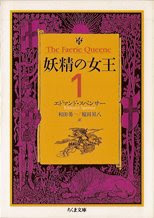 I don't know why I'm doing this. But here goes.
I don't know why I'm doing this. But here goes.Above are the first two pages of my Japanese edition of The Faerie Queene, which show the "argument" of Book 1, Canto 1 and the first three stanzas. Japanese, as you may know, is written (at least in books) from right to left and top to bottom, making it, like the rest of the culture, completely and incomprehensibly the opposite of Western practice. On the bottom of the page are notes, which I will probably ignore for now. I will also skip over the prefatory material in this volume, which includes the "Letter to Raleigh" and some dedicatory emblems. I may return to them later. I may skip around the poem, as well. Since I don't know Japanese perfectly (or pera pera, as they say), and even Japanese readers would find some of this stuff difficult, I can only take on challenges I am adequate to.
For this, the first and experimental post, I will just do the title.
妖精の女王
エドマンド スペンサー
The kana の in the title above is a possessive particle. The first word, which means "fairy," is a typical Japanese compound comprised of two Chinese characters, or kanji. Unlike Chinese characters in Chinese, which have one (or only a few) readings, Japanese kanji often and typically have multiple readings. There is a "Chinese" reading used, as here, in compounds (the "om-yomi"), and a Japanese reading ("kun-yomi"), used when the kanji stands alone. The first character above means charming or bewitching. It is itself comprised of the root, or radical, 女, woman, and another character (the right side), which looks to me like the character for sky or heaven, but it could also be, less probably, a rare radical that seems to mean either heaven or nothingness. In the latter case, of which I am more confident, we can safely assume that the East Asian mentality assigns the attribute of "bewitching" to women from the sky. Is that misogynistic? The fact that 女 is supposed to be a boob might be.
The second character in the compound means spirit, sprite, energy, etc. It is also used in the word 精子, which means semen. It is pronounced "seishi" which sounds like "sushi," and I believe the Japanese get a lot of mileage out of this. Very amusing. Its radical is the kanji for "rice," though here it probably doesn't carry a meaning. 米 is, incidentally, the kanji used to identify the United States. We're not Rice Land, though. 米 also carries the meaning of beautiful, so the USA is the beautiful country (米国). The other two components of this kanji mean, from top to bottom, born and moon. So put these two kanji together and you get "yousei," a bewitching spirit born of the moon, or, fairy. With の, we can expect the second kanji compound to complete a possessive phrase, something of the fairies. Note that Japanese doesn't distinguish between singular and plural. This can be confusing.
The second compound is easy. We already saw the kanji for woman (we? who am I talking to?). The second one means king. Even if you don't know how to pronounce it, the meaning is obvious: a woman king is a queen (or queene). Yes, you need the qualifier when it's a woman. A man king is just 王. So, the title of this poem is "The Woman King of the Bewitching Moon Sprites" or:
"The Faerie Queene"
by Edomando Supensaa, if you transliterate exactly the katakana used to render Spenser's name in Japanese.
That's it for today. Ideally, the fact that I'm doing this on a blog, whether or not anyone ever sees it, will keep me plugging away. I won't go into so much detail in most future posts, because it's time-consuming enough just translating the damn thing. For example, it took me like an hour just to find 妖 in a dictionary. Looks like a pretty simple character, right? Ha ha! It's not! It's Grade 8 out of nine grades, which means very uncommon, and it's not part of the standard 1945 character set certified for use in daily life. What a pain. But when the muscles hurt, we're getting the best workout, right?





No comments:
Post a Comment